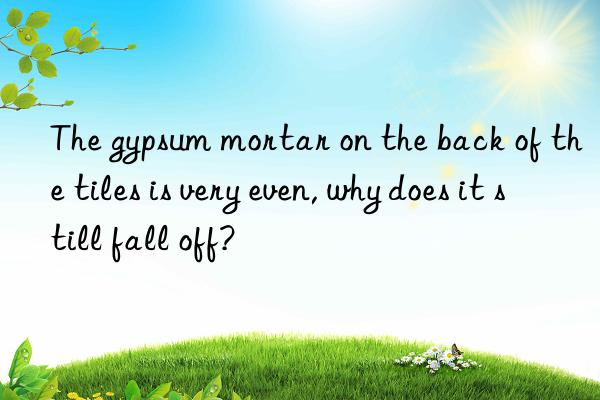
The gypsum mortar on the back of the tiles is very uniform. Why does the whole tile fall off? This topic bothers many people. Today, the editor will analyze the cause of the problem for everyone.
1. Material issues
Let’s start with the material. Whether it is home decoration or industrial decoration, wall tiles are generally divided into two types in terms of texture: glazed tiles and polished tiles. The two have different textures and different construction techniques. As the name suggests, glazed tiles are coated with a layer of glaze on the base. The base may be porcelain or pottery, and the pottery needs to be soaked in water. The body of polished tiles is porcelain, and the surface is polished by a machine. It has a high density and absorbs water. Rate ≤ 0.5%, no need to soak in water during construction.
(1) Glazed tiles. Either the degree of water soaking is inappropriate, or there is dust on the back of the bricks. If the water is soaked too lightly, the cement slurry cannot be fully immersed in the brick base body, and it will be dehydrated prematurely and will not solidify firmly. Soaking in too much water is not enough. When the bricks are saturated, it is easy to form a water layer and the bond is not strong. There is another situation that everyone needs to pay attention to, which is dust on the back. This situation usually occurs at the corners. The main reason is that when workers soak the tiles first and then chamfer, dust will stick to the back of the tiles, and the tiles will easily fall off after condensation. A similar situation occurs in every large-scale project.
(2) Polished tiles. The texture of polished tiles is all porcelain and does not need to be soaked in water. However, the cement slurry will not penetrate into the base layer of the tiles and the adhesion is insufficient. Therefore, polished tiles generally require Warhouse tile adhesive to increase the adhesion between the tiles and the gypsum mortar.
2. Base layer issues
There are several types of adhesion base layers for wall tiles: Air block plastering walls, concrete plastering walls, cement pressure plate plastering walls. Among them, air-entrained blocks and concrete wall plastering require the traditional construction process of spray grouting, but problems will still occur after about a year. (At present, in the construction market, concrete, air-entrained blocks, and cement pressure plate surface plastering are usually used. Warhaus building interface treatment agent can be applied directly to the base layer that needs to be plastered to ensure "0" hollowing, saving time, trouble and money) New technology for plastering concrete surface layer
Three , The ratio of cement to sand is wrong
Generally, wall tiles are 1:2, that is, 1 part cement, 2 parts sand, and then mix and paste. Many times, without accurate control, 1:4 or 1:6 is pasted on, which is very unreliable. It seemed to be glued on at the time, but it easily fell off over time. It was not a problem with the quality of the ceramic tiles!
4. The wall base was not watered
The wall base was not fully moistened before laying, causing the water in the gypsum mortar and bricks to be sucked away, and the mortar did not have enough solidification time. The humidity will prevent the tiles from being adequately bonded. Before paving, wet the base layer with water and control the humidity at 30-70%.
5. There are not enough seams in ceramic tiles
Ceramic tiles are ceramic products fired from natural soil, which will expand and contract with temperature changes. There are no seams in the tiles. The tiles will squeeze each other and fall off. Generally, a seam of 1~2mm should be left, just like the concrete pavement must be cut to leave seams.
6. Second tap
Many people find that the tiles are uneven after laying them, and they will flatten them with a second tap, which will cause the mortar that has lost part of its moisture to loosen. </p



 微信扫一扫打赏
微信扫一扫打赏
